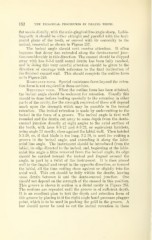Page 412 - My FlipBook
P. 412
182 THE TECHNICAL PBOCEDTJBES IN riLUNG TEETH.
flat mesio-distally, with the axio-gingival line angle sharp. Labio-
lingually it should be either straight and parallel with the hori-
zontal plane of the tooth, or curved with its convexity to the
incisal, somewhat as shown in Figure 257.
The incisal angle should next receive attention. It often
happens that decay has extended along the dento-enamel junc-
tion considerably in this direction. The enamel should be chipped
away with hoe 8-3-6 until sound dentin has been fully reached,
and in doing this very careful attention should be given to the
direction of cleavage with reference to the final inclination of
the finished enamel wall. This should complete the outline form
as in Figure 249.
Resistance form. Special resistance form beyond the reten-
tion form is not required in these cavities.
Retention form. Wlien the outline form has been attained,
the incisal angle should be undercut for retention. Usually this
should be done before looking specially to the retention in other
parts of the cavity, for the strength required of these will depend
much upon the strength which may be possible in the incisal
retention. The incisal retention is made by undercutting to the
incisal in the form of a groove. The incisal angle is first well
rounded and the dentin cut away to some depth from the dento-
enamel junction directly at right angles to the axial surface of
the tooth, with hoes 8-3-12 and 8-3-23, or equivalent hatchets,
using angle 23 mostly, close against the labial wall. Then hatchet
5-3-28, or, if that blade is too long, 3-2-28, is used for cutting a
groove in the incisal angle, and extending it along the labio-
axial line angle. The instrument should be introduced from the
labial, its edge directed to the incisal, and, beginning at the labio-
axial line angle a little removed from the incisal angle, its edge
should be carried toward the incisal and lingual aroimd the
angle, in part by a twist of the instrument. It is then placed
well to the lingual and swept in the opposite direction, or toward
the labial, all the time cutting close against or slightly into the
axial wall. This cut should be fully within the dentin, leaving
some dentin between it and the dento-enamel junction. One
should not depend on the strength of the enamel in this position.
This groove is shown in section in a distal cavity in Figure 255.
The motions are repeated until the groove is of sufficient depth.
It is an excellent plan to test the depth and retention form of
this groove by placing in it the right angle hand -pressure plugger
point, which is to be used in packing the gold in the groove. A
bur should never be used to cut the incisal retention in these


